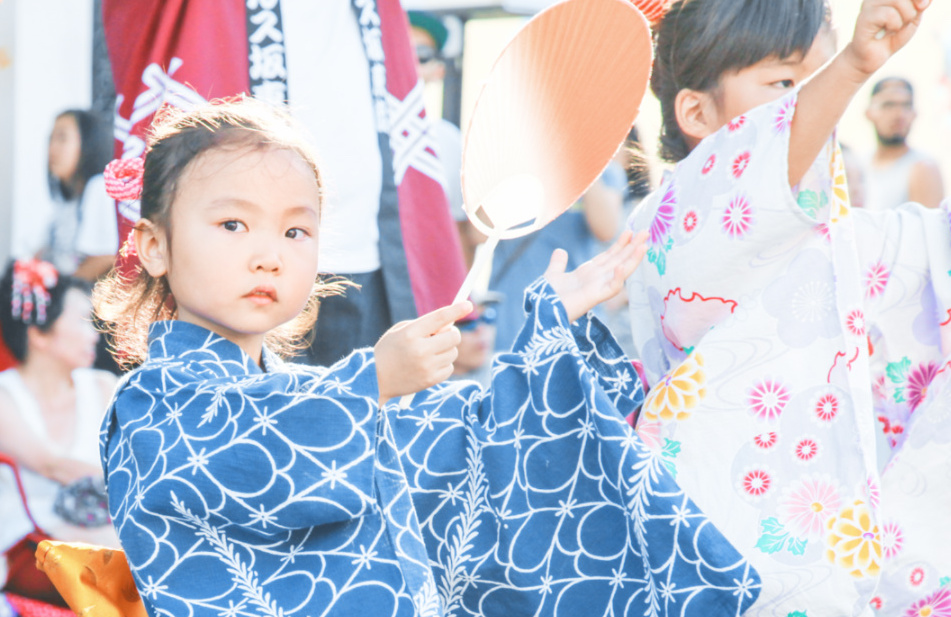In normal times, the Nisei Week grand parade attracts a sea of people dancing and shouting in a public display of love and community pride. (Photo: Courtesy of Toyo Miyatake Studio)
The love affair between the place and its people has endured generations, but where is this love grounded, and how does it continue through uncontrollable forces of change?
By Lynda Lin Grigsby, Contributor
Once upon a time, there was a place where many people felt warm and comfortable. It was a place that welcomed the beleaguered masses to rest their weary bones and joyfully dance in the streets. For generations, the connection between the place and its people flourished like an epic love story.
One of the main characters in the story is a five-block district in Los Angeles. Because anyone who loves Little Tokyo knows it is alive.
The palpitation of human feet on the sidewalks orchestrates its heartbeat. Its storied history shapes its soul, and its neon lights beckon its long-lost lovers to return. For all its darkness and light, Little Tokyo inspired historical books and Hollywood mystery movies, but at the core, it is a love story.
“There is a certain level of nostalgia that really anchors your heart,” said Nancy Okubo, president of the Nisei Week Foundation, which organizes the annual festival that takes over the streets of Little Tokyo in a normal August.
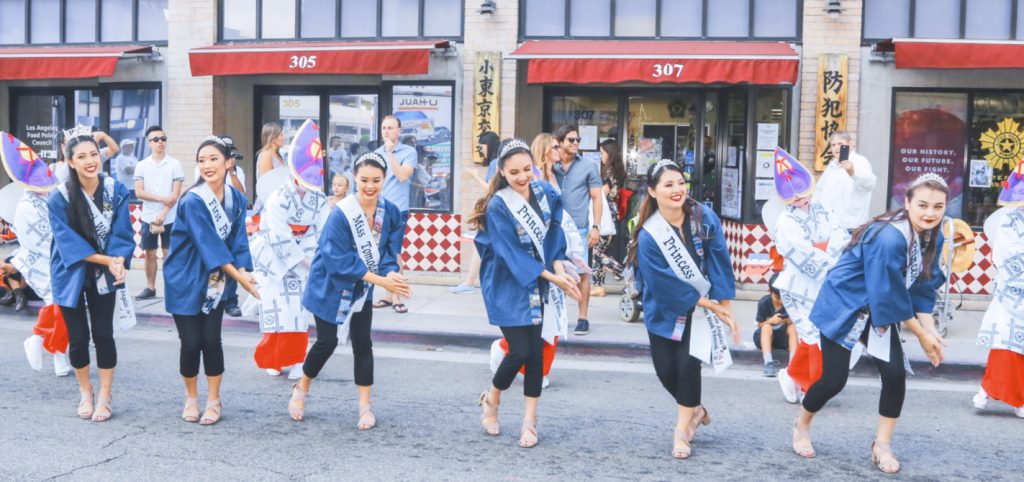
Among the grand parade highlights is the Nisei Week royal court, shown here dancing in an undated photo. (Photo: Courtesy of Toyo Miyatake Studio)
But this is not a normal time. For the second year in a row, Nisei Week was a virtual event. On the Saturday when the virtual celebration went live on YouTube, the streets of Little Tokyo were quiet, except for echoes of an anti-vaccine rally that turned violent a few blocks away at Los Angeles City Hall.
In a pandemic, the love story between Little Tokyo and its people has turned into a long-distance relationship. Distance and time are forces that can change the dynamics of a relationship that, at the very least, came to rely on rituals and annual events to bring people back to their place. What happens to the relationship when these cultural touchstones are physically absent?
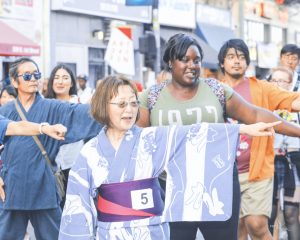
The appeal of Nisei Week stretched far beyond its Nikkei origins. (Photos: Courtesy of Toyo Miyatake Studio)
This year’s virtual Nisei Week theme, “Ibasho,” reflects the community’s reckoning with its changing relationship with the place. In the absence of its people, Little Tokyo continues to morph and change. Shuttered storefronts dot the cityscape next to longtime family owned and new businesses. Ibasho is a Japanese word that means “a place to belong,” and it lays the foundation for the question: How do you find belonging in a place that continues to change?
If this is a love story between people and a place, then at this critical juncture, it is prudent to examine where the love is grounded and how to find connection points when forces of change continue to shift the relationship.
And like any other modern-day romance, a good place to start with this reckoning is with a therapist.
Start With Honoring the Grief
Dr. Lisa Nakamura is a clinical psychologist in Oakland, Calif. She specializes in helping individuals and families cope with mood disorders and intergenerational trauma. She is also a Sansei, who grew up deeply connected to San Jose’s Japantown. Because of her experience working on the Tule Lake Committee, she smoothly adapts her expertise from humans to an interaction between people and a place.
In the relationship between Little Tokyo and its people, Nakamura says, it is important to recognize that a lot of rapid life changes can make people feel uncertain. Last March when Los Angeles city officials issued stay-at-home orders to fight the spread of Covid-19, Little Tokyo businesses closed or tried to pivot while many people worked from home. For the area’s residents, whose median age skews older than the rest of the city, the threat of Covid-19 restricted movement.
Almost overnight, the district’s bustling streets fell quiet. Its pulse weakened. In 2020 and ’21, more than 20 Little Tokyo business closed, including its 111-year-old institution Mikawaya. These closures can be small shifts in the cityscape, but the effect can be much larger in a community that built connections despite historic losses.
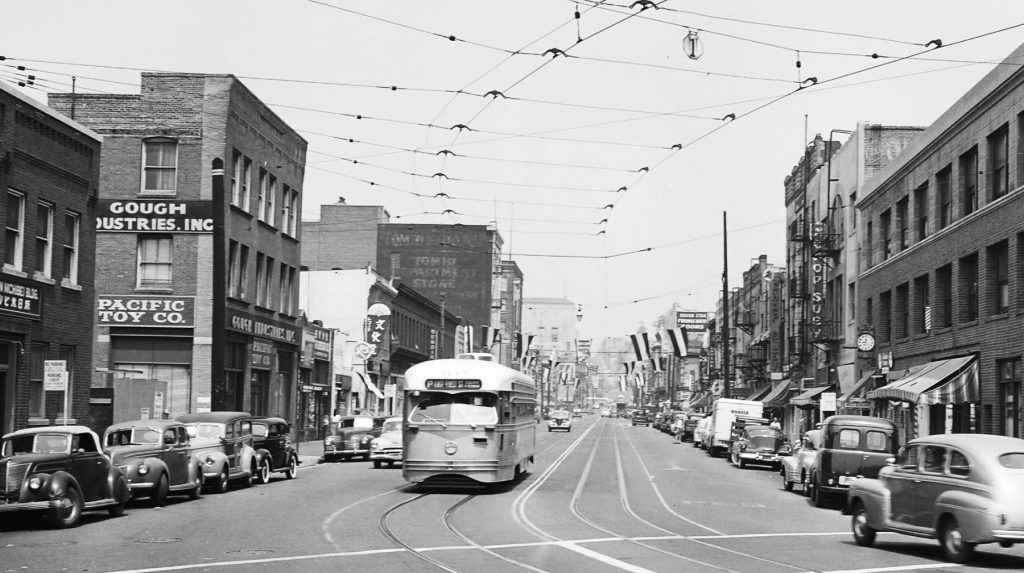
Historic Little Tokyo (Photo: Courtesy of Toyo Miyatake Studio)
For the Japanese American community, said Nakamura, a space like Little Tokyo is sacred because it — like its people — survived the World War II incarceration. Brick-by-brick it was reclaimed and rebuilt after the forced removal of its people.
To love Little Tokyo means to see the beauty of its brutal history. Poets, philosophers and artists of many kinds have spent lifetimes trying to put a precise definition on the elusive sensation of love, leading American writer Susan Sontag to throw up her hands in surrender to its majesty and write, “Nothing is mysterious, no human relation. Except love.”
The love of Little Tokyo starts as a place of community. It is a place a person can leave, come back and, in most cases, fit right back in. It’s the idea of going to a place and running into people who know family members and have a shared history.
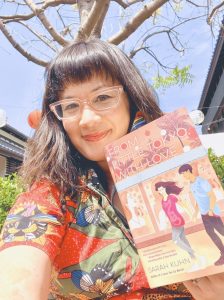
Sarah Kuhn is the author of “From Little Tokyo, With Love,” a new young adult romantic love story. (Photo: Courtesy of Sarah Kuhn)
“It’s being surrounded by so much history, by so much culture, by a sense of place and the sense of neighborhood and community, and also being surrounded by so many Japanese American people of all different experiences and all different walks of life,” said Sarah Kuhn, an author who writes about the magic of the place in her new book, “From Little Tokyo, With Love.”
Love also blossoms in the connection to beloved foods — like the warm feeling of always having a home-cooked meal or trusted access to a sweet ice cream mochi treat. When these connections vanish, it can feel devastating.
It is important to honor that grief, said Nakamura. Pay attention to the feelings of what you miss about the place, what you wish you had done, and did not get to do.
“Once you have some level of acceptance for that loss, then you can make room for what the relationship could look like,” she said.
Write Your Feelings
Last summer, when Los Angeles was in one of its coronavirus surges, Kuhn wrote most of “From Little Tokyo, With Love,” a contemporary young adult novel about Rika Rakuyama, a judo-loving biracial Japanese American young woman, who rhapsodizes about her neighborhood of Little Tokyo like it is a magical living being.
“When I walk those streets, I can feel that. That sense of history and community and struggle and passion,” Rakuyama says in the book. “There are so many stories jammed into every block — the whole neighborhood feels so alive.”
“From Little Tokyo, With Love,” the author says, is a fictionalized version of the real Little Tokyo with some references of places she loves like Bunkado, Suehiro and the garden at the Japanese American Cultural and Community Center.
The novel also centers Little Tokyo in the similar way New York often gets romanticized in movies and books. If the Empire State Building can be an iconic romantic rendezvous point (Deborah Kerr’s character gets tragically hit by a car in front of the landmark in 1957’s “An Affair to Remember”), why can’t the garden at the JACCC?
“It just feels like it is a setting for a modern fairy tale,” said Kuhn about Little Tokyo.
Like Rakuyama, Kuhn is a biracial Japanese American woman who struggled to find a place to belong — her Ibasho. She grew up in a small town in rural Oregon and came to Little Tokyo as an adult.
“I do remember that as soon as I set foot there, I did feel very much at home,” she said. “It was sort of this heart connection. And I think the only other time I really felt that is when I’ve been amongst my family or my close friends.”
“From Little Tokyo, With Love” is a love letter to a place, written almost entirely from a pandemic-induced distance. Kuhn said this was difficult because she could not witness the color and vibrancy of the neighborhood and all its traditions.
“I started to feel a little bit weird because I was writing a contemporary novel that is supposed to be set in our world, but the version of our world I was writing about seems like science fiction,” she said.
Let’s be honest, distance can make a person feel a certain way about a relationship. At a year and half into the pandemic, Zoom fatigue is real, and enthusiasm for virtual experiences is threadbare. Distance can erode a connection, or it can make the heart grow fonder.
“Maybe it will increase the appreciation for what we had,” said Okubo, who is the Nisei Week Foundation’s first pandemic president. The 2021 Nisei Week virtual experience went live Aug. 14 on YouTube, where it is available for replay.
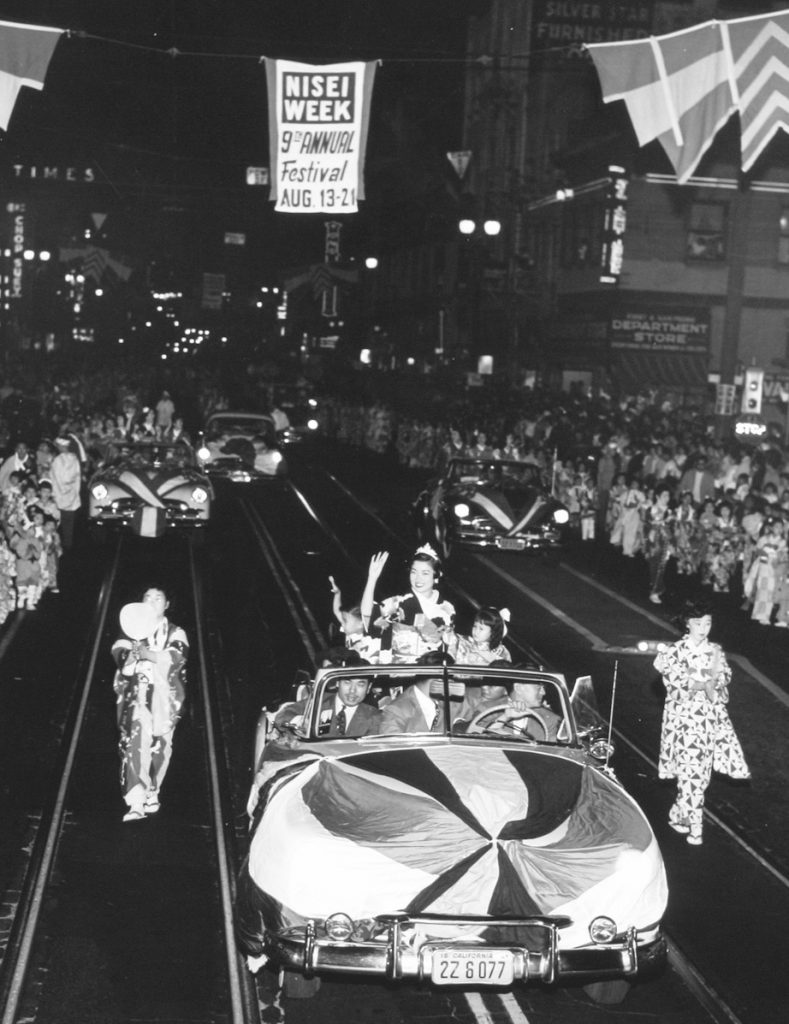
The Nisei Week grand parade took over Little Tokyo’s streets in 1949. (Photo: Courtesy of Toyo Miyatake Studio)
The Nisei established the festival in 1934 during the Great Depression to help revitalize Little Tokyo businesses. It is one of the longest-running ethnic festivals in the United States, according to the Nisei Week website. Events that happen year after year for decades can be taken for granted — like indoor dining at restaurants or watching movies in theaters with strangers. In their absence, there is a sense of loss and a hope for revival.
This is not the first time Nisei Week was interrupted. During WWII, the festival went dark when its people were forcibly removed. Then in 1949, it roared back. Next year will be Nisei Week’s 80th, with a hope of an in-person celebration.
For now, a fictionalized version of the festival is written in “From Little Tokyo, With Love” based on Kuhn’s real-life love and imagination. In the novel, Rakuyama describes the grand parade in a way that stir memories and feelings:
“I love the parade, because it’s the one day a year when all the magic bubbling under the surface of Little Tokyo comes out to play, amplified by the wonderstruck crowds of locals and tourists. The cavalcade of bright colors is more vibrant, the creepy hidden-away nooks and crannies are even darker and the juxtapositions of things that shouldn’t go together are just more. That crumbling, overstuffed souvenir shop crammed next to the modern swoop of the most elegant hotel in the city looks even more beautifully improbable.”
Help Shape the New Relationship
Little Tokyo has always survived under threat, said Michael Okamura. Its location two blocks away from Los Angeles City Hall has always made it a precarious target for expansion of civic area.
The origin of Little Tokyo, like other ethnic enclaves at the turn of the century, is a sad story about people who came together because they could settle nowhere else. In 1884, Charlie Hama was the first Japanese American to open a business — an American-style café on East First Street called Kame Restaurant. The neighborhood grew from there, said Okamura, president of the Little Tokyo Historical Society.
Okamura’s paternal grandparents, Toshiyuki “Boshicho” and Chiharu Okamura, met and married in Little Tokyo. Later, they owned and operated Toyo Florist & Nursery on the parcel of land that today is Toriumi Plaza.
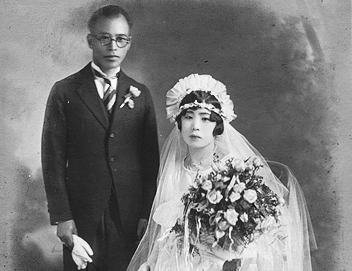
Toshiyuki “Boshicho” and Chiharu Okamura got married in Little Tokyo in 1927. (Photo: Courtesy of Bunkado)
When Okamura walks around Little Tokyo, he walks in the footsteps of his ancestors. In a pandemic, there are fewer opportunities to do this except on weekends, when he goes to the LTHS office to shift through mail. During these trips, he sees Little Tokyo changing — vacant storefronts appear, non-Japanese American businesses move in and an encampment of unhoused people settle in a corner of Toriumi Plaza.
“Change is one of those things you love, and you hate,” said Irene Tsukado Simonian, owner of Bunkado gift shop.
Love it or hate it, Little Tokyo is changing. Psychologists say the feeling of discomfort that arises from life changes could be a good sign — it is an opportunity for emotional growth.
“I almost feel like this is an opportunity for sharpening our ways to adapt to a situation and to think about how there are other ways of creating community,” said Nakamura.
If people are open to it, how can one be creative and include some of those voices in a spirit of renewal? Love is not fixed. It can morph and stretch infinitely.
“And you can help shape it,” said Nakamura.
In a scene “From Little Tokyo, With Love,” community members gather in a room and reckon with its rigid adherence to tradition — at the expense of inclusivity.
“Communities need to change and grow along with the people in them,” said Auntie Och, one of Rakuyama’s no-nonsense aunties.
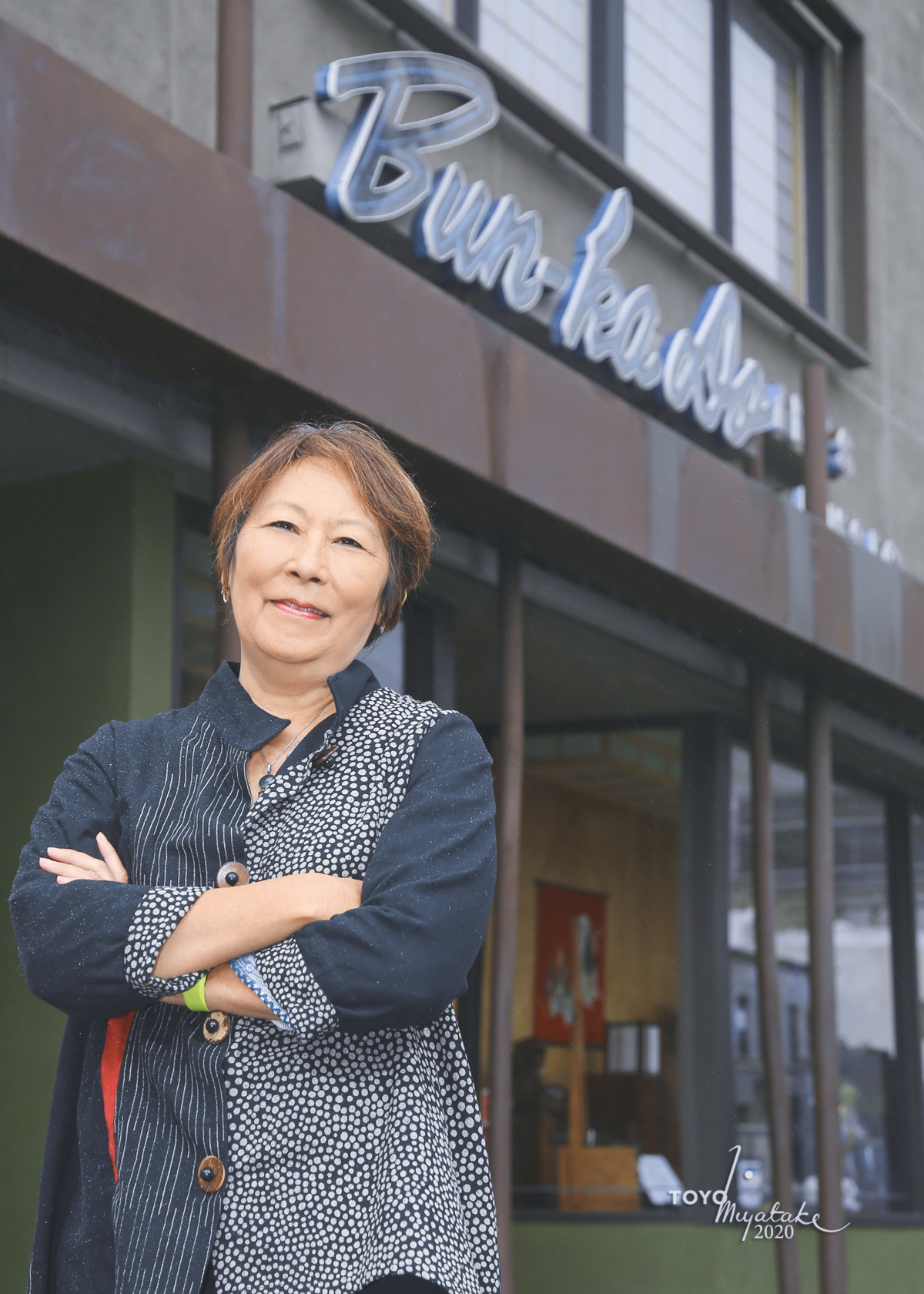
“It’s very important just because of its staying power,” said owner Irene Tsukada Simonian about Bunkado gift shop, a Little Tokyo legacy business. (Photo: Courtesy of Toyo Miyatake Studio)
It’s a sentiment Bunkado’s third-generation owner echoes in real life. Founded by her aunt and uncle, Suye and Tokio Ueyama, the Little Tokyo gift shop celebrates its 75th anniversary this year. Tsukado Simonian’s parents, Masao and Kayoko Tsukada, ran a different gift shop called Tsukada Company nearby. In the 1970s, they combined the two businesses at Bunkado’s current location.
The feeling that Little Tokyo is just for Japanese Americans prevailed during the Issei generation, said Tsukado Simonian. Today, boba shops and Korean barbeque restaurants share retail space with longtime Japanese American-owned businesses like Anzen Hardware and Fugetsu-Do Confectionery.
“There are non-Japanese businesses that are coming to Little Tokyo, and that’s OK,” said Tsukado Simonian. “If there’s some appreciation for the culture. I think it’s part of the success of the community.”
Little Tokyo love is a symbiotic relationship between business owners and the visitors who love and appreciate the place. Tsukado Simonian calls it a “magic sauce.”
The pandemic created many losses, but also some gains in the staying power of businesses like Bunkado. Tsukado Simonian grew up in Little Tokyo, where she felt she had no privacy until she moved away to New York and had nothing but anonymity. The gift shop called her back home.
When she works in the store, the acoustics make it so that every comment is perfectly audible. Mothers come in with their children to walk the same aisles that they did as little girls with their bachans. Those comments flow directly into Tsukado Simonian’s heart.
These days, when she walks through Little Tokyo, she likes to approach visitors who look lost. She stops and gives directions because she cares.
That is what you do when you love.
Kuhn walked by Bunkado one day and saw copies of her book on display in the window next to “My Neighbor Totoro.”
“I feel like that is like a very high compliment,” Kuhn said.
The author signed copies of her book to sell at the gift shop she referenced. It’s a scene that blends real life with romantic fiction in a modern-day fairy tale that really can only happen in Little Tokyo.

